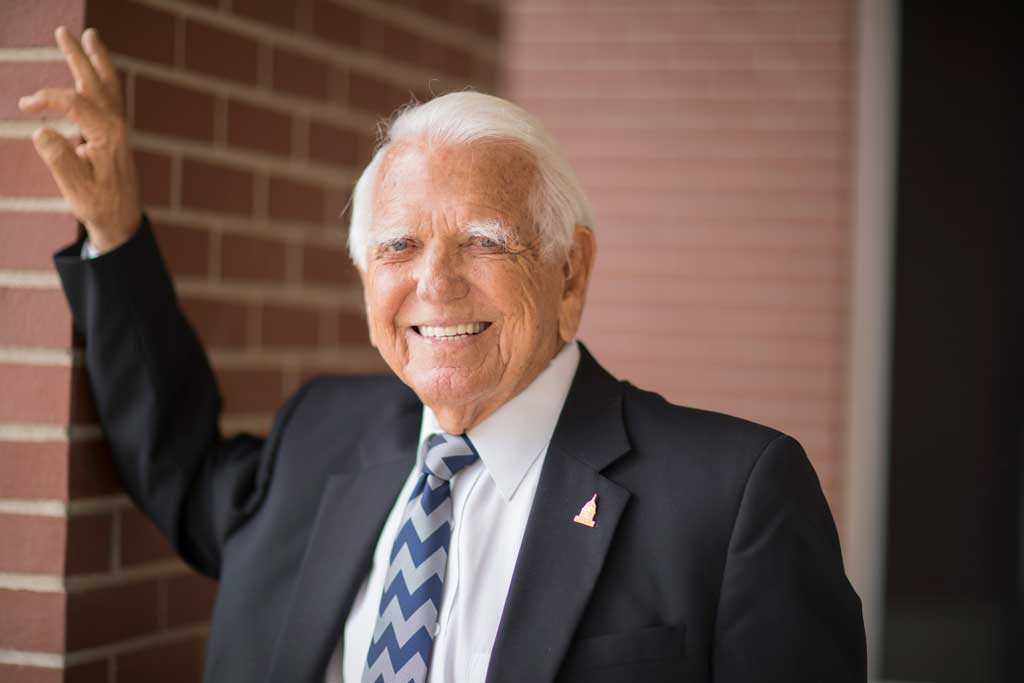
From Oklahoma’s longest-serving governor and lieutenant governor – the elder statesman of Sooner politics – comes a straightforward solution to the state’s continual budget crises: Don’t draw lines.
At 90, George Nigh says he always tried to remember that tactic while in elected office, 1951-1987. He had success because he is the only gubernatorial candidate to carry all 77 counties – not just once, but twice. And he’s a Democrat in highly conservative Oklahoma.
“The problem is drawing a line in the sand too early,” he says. “If you say, ‘My opponents won’t agree to this or I won’t agree to that,’ then you don’t allow yourself to have a conversation. It’s a tough decision. I’d like to get rid of the word compromise and insert the word consensus, because compromise often means someone has given in. Consensus is an easy word to use.”
In 1950, Nigh was a fresh graduate from East Central State College in Ada and a new Oklahoma history teacher at McAlester High School when he became, at 23, the youngest person elected to the state House. (Elise Hall broke the record; she was 21 when sworn into office in 2011.)
“I was the youngest member of the state Legislature when I was elected in 1950. Now I’m the old guy.”
Nigh remains passionate about education because “I want to be around these young adults.” With annual treks to Boys State and Girls State, Nigh retains the zeal of a dedicated teacher. He iterates his line-drawing metaphor when discussing Oklahoma’s exodus of experienced educators because of low pay and large class sizes.
“How do you increase taxes to pay for education?” he asks. “Politicians are fearful to raise taxes that the public won’t like. If you draw a line on taxes, then you can’t raise teacher salaries and reduce class sizes. Hold off drawing too many lines.”
Nigh says consensus (that word again) is committing to robust funding of public education.
“You shouldn’t have to move out of state to be successful,” says Nigh, evoking the names of famous Oklahomans. “That’s what I tell young people. Tom Stafford literally went to the moon and back. Tell Garth Brooks. Tell Toby Keith. Tell Carrie Underwood. Tell them that they can’t do it from here.”
Nigh cites himself, too.
“In ninth grade, our Oklahoma history teacher had us write down what we wanted to do,” he says. “I wanted to be governor. I have nothing against public service. The only way to become governor is to offer yourself. We need young people to run for public office and encourage public service.”
George Nigh’s Records
After George Nigh became the first Oklahoma governor to be re-elected, Frank Keating and Brad Henry followed suit; Gov. Henry Bellmon had two non-consecutive terms. But Nigh is the longest-serving governor because he had two abbreviated terms (nine days in 1963 and five days in 1979) when J. Howard Edmondson and David Boren resigned so they could take U.S. Senate seats early and gain bits of seniority.
Nigh was the longest-serving lieutenant governor, 1959-1979, because Oklahoma’s constitution allows unlimited terms for that position. A governor couldn’t run for re-election until 1970, when David Hall defeated incumbent Dewey Bartlett. In 1974, Hall lost a primary to David Boren, who, instead of running for re-election as governor in 1978, was elected to the U.S. Senate. That allowed Nigh to run for governor for the first time; he was re-elected in 1982.
Click here to read the extended web-exclusive interview with Nigh.


























